Events - 2022
Veteran Community leader Gobind Munjal is inaugurated as President of The Association of Indians in America - Sunday February 6th 2022



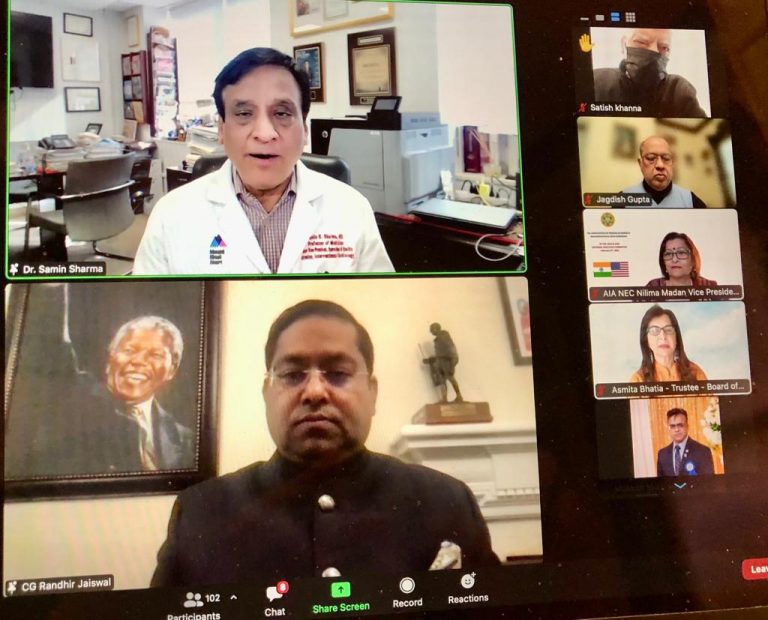
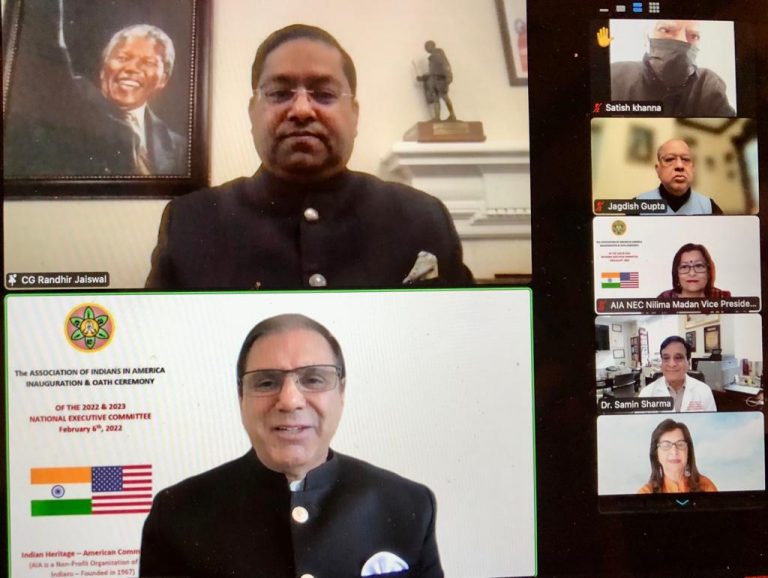
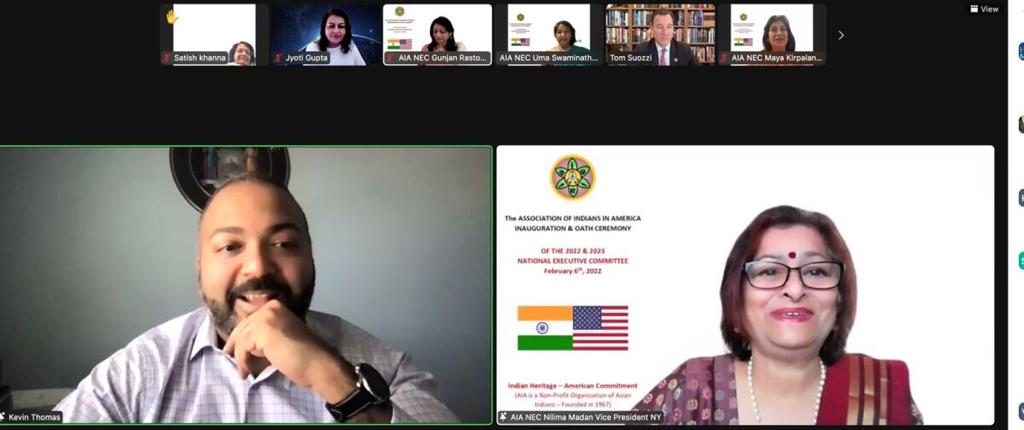
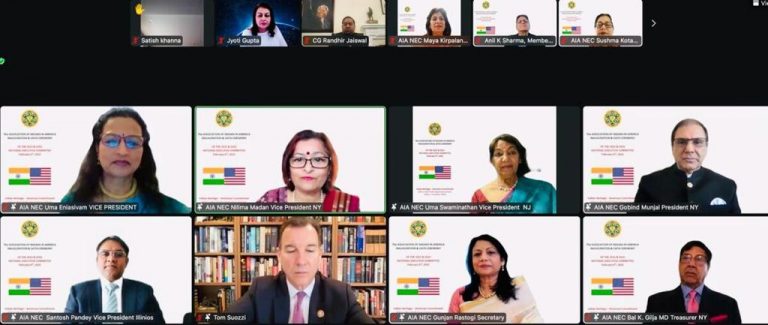
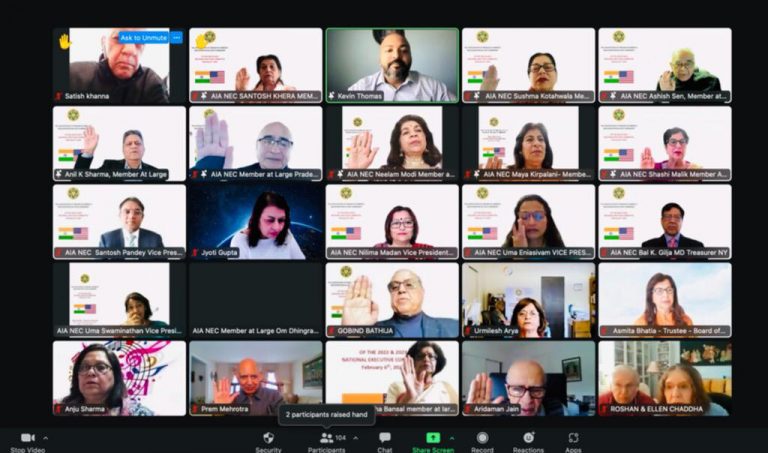
Gobind Munjal, the newly elected National President of The Association of Indians in America (AIA), was sworn-in along with his National Executive Committeein an exciting Inauguration ceremony arranged virtually on Sunday February 6,2022. The occasion was graced by the chief guest Honorable Consul General Randhir Jaiswal, Hon.Congressman Tom Suozzi, and Hon.New York Senator Kevin Thomas.The Inauguration and Oath ceremony was attended by well over one hundredattendeesand their families. This included AIA founding members, board of Trustees, AIA National Past Presidents, AIA current and past chapter Presidents, community leaders, AIA members, friends, and all the media partners. Bharat Ratna legendary singer Lata Mangeshkar was given homage by observing a moment of silence. It was followed by melodious singing of American and Indian National Anthem by Gita Setia. The Chairman Board of Trustees,Dr Samin Sharma initiated the program and spoke briefly about AIA. Chief Guest Hon. Consul General of India in New York, Randhir Jaiswal. in his opening Remarks, praised AIA for all that it has done for the community during its 55 years of history and commended the organization for sending oxygen concentrators to India in 2021. He also pledged to work with AIA for outreach to the community. National President Gobind Munjal was sworn-in by Honorable Congressman Tom Suozzi, who also administered the oath to Vice Presidents Uma Swaminathan(NJ), Nilima Madan(NY), Santosh Pandey (IL), Uma Eniasivam (Fl), Secretary Gunjan Rastogi (NY) and Treasurer Dr. Bal Gilja (NY). Honorable NYS Senator Kevin Thomas had the honors for swearing-in the members at large from all the states, namely Anil Sharma (IL),Aridaman Jain (NJ),Ashish Sen (IL),Dr. Bharti Palkhiwala (NJ),Dr Binod K. Verma (NY),Gobind Bhatija (NY), Manoranjan Mishra (IL),Maya Kirpalani (FL), Neelam Modi (NY),OM Dhirgra (IL), Pradeep Tandon (NY), Prem Mehrotra (IL), Rajeev Chaudhary(NY)Ram Khanna (NY), Santosh Khera (NY),Sharmistha Dutta (FL),Shashi Malik (NY),Sujata Seth (NY),Sushma Kotahwala (NY),Usha Bansal (NY).
In his speech, National President Munjal welcomed everyone and shareda glimpse of his vision.
Read MoreAIA Organizes a conference on “What is Awareness and Empathy and How Can We Increase Them In Us” - Monday May 16th 2022

National AIA President

On May 16th, “The Association of Indian In America”(AIA) National Executive Committee organized a conference on What is Awareness and Empathy and How Can We Increase Them In Us.The idea for this conference was conceived by Mr. Gobind P. Munjal, President of National AIA, Asmita Bhatia, Trustee of AIA and Professor Shivaji Senguptaof Boricua College. He has recently retired from there as Professor of English and its Academic VP. Boricua isa small, private, not for profit liberal arts institution in New York City. As vice president, he worked with the full-time faculty to develop awareness and empathy so that they may be better facilitators of learning. He was thus invited to lead the discussion. The meeting opened at 8:30 PM. There were over 42 attendees, all participating via Zoom. Ms. Gunjan Rastogi, the National AIA Secretary, introduced National AIA President Gobind Munjal. Mr. Munjal said in his introduction to Dr. Sengupta that we are living in a sharply divided world. There is the war in Ukraine which shows no signs of abating. Internally, sharp differences between the political parties and social groups were tearing the country apart with unrest and violence. These are all happening because of lack of communication between people. In this milieu, Gobind Munjal said, it would be a good idea to discuss awareness and empathy, how developing them may help others.
Shivaji Sengupta began the discussion by explaining what he means by awareness and empathy. Awareness is being conscious, not only of the environment around us, the atmosphere, the people, nature, but also conscious of how we are feeling as we are aware of them. It is the latter – how we are feeling – that is hard for us to be aware of, Sengupta said. Empathy is the ability to gauge the feeling of a person one is in the company of. This ability to “be in someone else’s shoes,” as they say, the ability to communicate with feeling and self-awareness, is empathy.
But awareness and empathy cannot happen without contact. Sengupta explained contact as not only being in touch with someone but being aware of the nature of the contact itself. Are we happy, sad, troubled, anxious about being in contact with a particular person? Contact, he said, is not instantaneous and sudden. It is a process. Awareness is its consequence. We need to nurture contact if we are to develop empathy.
Empathy, unlike sympathy, is active. When in empathy, we reach out to help. Sympathy is more intellectual, aloof; empathy is affective. Affect is our ability to monitor our feelings, be aware of them before we react. Empathy is functional; sympathy, inert.
Thus, Professor Sengupta established a continuum between Contact, Awareness and Empathy. He said there are other elements that we need to know to enhance awareness and empathy such as field and energy that the Bhagwat Gita callskshetra. There is also the notion of control and difference. All of this help someone to work with differences among people, to bring about mutual understanding and empathy and resolve conflicts. However, given the complex subject, he said he would explain these terms at a subsequent session.
AIA hosts second session on awareness and empathy - Thursday June 16th 2022
On Thursday June 16th, exactly a month after the first session, the Association of Indians in America (AIA) hosted its second conference on Awareness and Empathy at 8 PM. National President Gobind Munjal welcomed all the attendees including some of AIA’s past presidents and trustees.
Mr. Munjal introduced the speaker Dr. Shivaji Sengupta and the moderator Asmita Bhatia, trustee of AIA.
As in the first session. Shivaji Sengupta led the discussion. Moderator Asmita Bhatia helped start the discussion by making the parameters of the present session clear. Although awareness and empathy can be successfully used in many situations, private, corporate and political, she said, our discussion was going to be limited to two areas: personal relationships between family and friends, and about relationships in the workplace.
At Mr. Gobind Munjal’s suggestion, Sengupta began by restating the definitions of Awareness and Empathy. Awareness is our ability to be conscious of our environment, particularly, the people, but it also includes our being conscious of our own selves, especially in terms of our feelings. He explained Empathy as being able to intuitively understand how another person is feeling as he or she is engaging you over an issue important to both.
Next, Shivaji Sengupta said that Awareness and Empathy are both states of being: you are aware of someone or something: you are in a state of empathizing with another person. He explained that while everyone has awareness and empathy these two can be developed into skills. How? By constantly practicing the subskills that culminate into Awareness and Empathy. These skills are Observing, Listening, responding with nvolvement and feelings (Asmita Bhatia added these two conditions). Skillful observation makes you select the object of your choice with controlled attention and focus. It is possible to raise this to a skill level by constantly practice, selecting out a figure from the ground where the observation is taking place, controlling your power of attending and focusing sharply on the object. Similarly, responding has subskills also which, with practice, turns into a skill.
These subskills are acquiescence in responding and satisfaction in response. If we are interested in and involved with the object of our attention, we transit from acquiescence to satisfaction in response.
Dr. Sengupta’s ideas led to a lively discussion among the members. They took up one another’s points and elaborated on them. Gunjan Rastogi asked what does one do when one of the parties in discussion turns hostile and offensive? Withdrawing temporarily, was the answer, keeping open all the i channels of communication and letting the hostile person be aware that the channels are open. What is the difference between hearing and listening? Asked Nilima Madan. Hearing is general, while listening is more specific. Listening is targeted hearing. Dr. Bharti Palkhiwala spoke of the importance of eye contact, and periodic responses that told the speaker that the listener was genuinely intersted in him/her. Se called it building an alliance with the listener.
Asmita Bhatia spoke of the importance of calmness as one is taking to a hostile person. Sengupta elaborated that this calm withdrawal is not a final withdrawal.
The engagers need to remember their purpose of the discussion and whether differences in values in (male/female; parent/child,supervisor/supervisee) are preemtory (unnegotiable) or ameliorative (can be discussed further at least in terms of methods of achieving a goal).
Mr. Gursharan Kalra pointed out whether with a change in one’s status (in life or in society) one can be in a difficult position in terms of others’ expectation. Sengupta replied yes, and in such cases, it is best to be authentic, accept that one’s status in life has changed, but plead to be accepted as one is now. Uma Swaminathan asked whether there is a difference between the way a male observes and responds from the way a female does the same things. Curiously, interesting as this question was the question wasn’t discussed in much detail, which it deserved. Shivaji Sengupta is still thinking about this question and would like to get back to Ms. Swaminathan on this.
To bring out some of these is sues, Shivaji Sengupta gave a summarized situation of a father and daughter who were engaged in a controversial situation, putting the parent and offspring on culturally: opposite sides. Sengupta described how the father engaged his daughter into roleplaying by taking the opposite viewpoint and arguing in favor of it The daughter became the father the father became the daughter. In doing so, Sengupta, said they had an almost first-hand feeling about what it is like to be in the other position Empathy developed in each, the daughter, and the father. In the end, the parents asked the daughter to decide, now that she had considered both the father’s and the daughter’s points of view. The parents assured the daughter that whatever she decided, the parent would accept. Finally, the outcome was favorable. Many participants appreciated the narrative as a prime example of developing empathy.
The members all agreed that this second session on Awareness and Empathy was full of lively, intelligent and intellectual discussion and was a huge success. There was even talk of continuing this trend and most of the attendees requested the management to have a third session for more discussions of this type both via Zoom and in person, as these issues are real and need more insight into this. Mr. Munjal responded that they will send the recording to everybody who were not able to attend the session due to prior commitments and would very actively think about it, if most of those people also would want it. The program was concluded at 9:30 PM by vote of thanks from the National Secretary Gunjan Rastogi.
